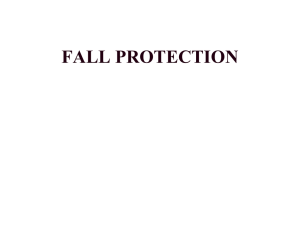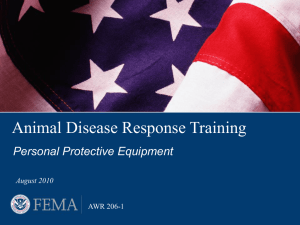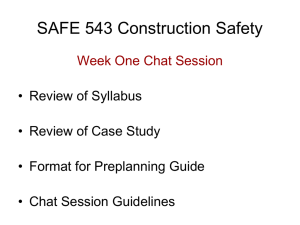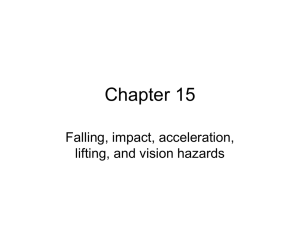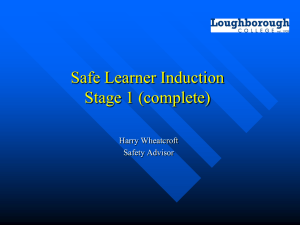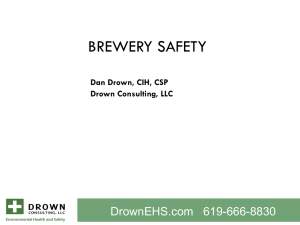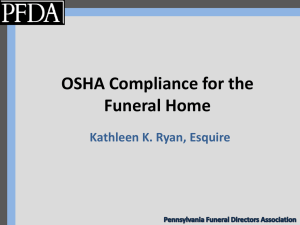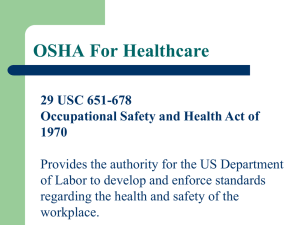PPE-Presentation
advertisement
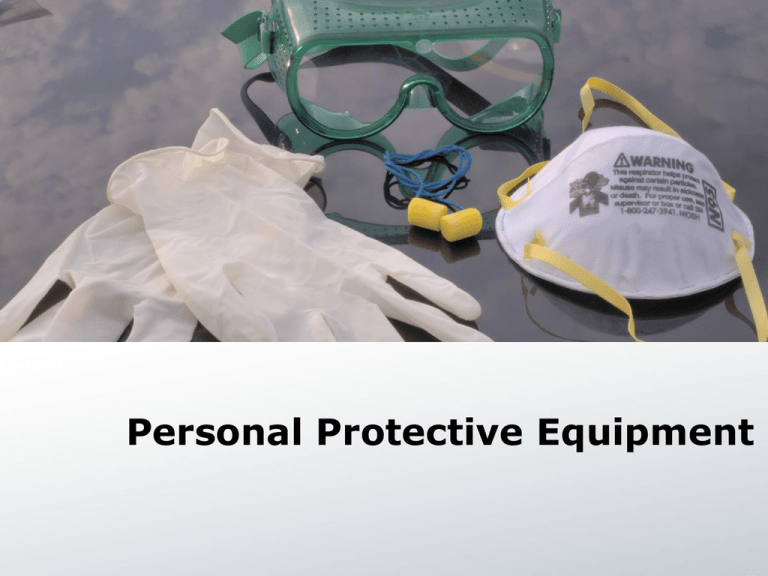
Personal Protective Equipment Injury Statistics • Nearly two million people have a debilitating work-related injury each year, with more than a quarter of these injuries involving the hands, eyes, head and feet. • Over 41 million people have accidents that require an emergency room visit per year. • A little over five thousand people die from occupational injuries annually. What is PPE? Personal protective equipment (PPE) is designed to protect workers from health and safety hazards that cannot be removed or engineered out of the working environment. OSHA Policy 29 CFR 1910.132 Under the requirements of OSHA Policy 29 CFR 1910.132: Engineering controls shall be put into place as the primary method used to eliminate hazardous exposures in the workplace. PPE shall be provided, used and maintained in sanitary condition. Each affected employee should wear the necessary PPE at all times after the employer conducts an analysis of the jobsite and instructs employees what to wear. OSHA Policy 29 CFR 1910.132 Conducting a Hazard Assessment: Employers should pay particular attention to the following sources of injury when conducting a hazard assessment of the workplace: • • • • • • • Motion High temperatures Chemical exposures Harmful dust Light radiation Falling objects Sharp objects • Layout of the workplace • Electrical hazards • Rolling or pinching objects • Current accident and mishap data to identify further problem areas OSHA Standard 29 CFR 1910.133 Eye and Face Protection: • Eye and face protection should be worn when there is a reasonable probability that an injury can be prevented or reduced by wearing equipment. Instances include: o o o o Flying objects Splashes from liquids (acids, solvents, caustics, etc.) Hot slag and molten metal Welding glare • Types of eye protection available: o o o o o Safety glasses Goggles Face shields Welding helmets Full hoods OSHA Standard 29 CFR 1910.133 Eye and Face Protection Purposes: • Safety glasses and goggles: o Wear under face shields and welding helmets for added protection. • Tinted/shaded lenses: o Wear to protect against glare. • Numbered lenses: o Wear to provide protection against radiant energy in fields such as welding. OSHA Standard 29 CFR 1910.133 Eye and Face Protection Limitations: • Tinted or shaded lenses: o Limit vision when moving from bright to dim areas. • Prescription lenses: o Dust can get caught underneath the lenses. o Chemical reactions can occur with contacts. OSHA Standard 29 CFR 1910.134 Respiratory Protections: • Respiratory protection should be worn when there is a reasonable probability that workers will be exposed to the following hazards: o Dust o Fogs o Fumes o Mists o Gases o Smoke o Sprays o Vapors OSHA Standard 29 CFR 1910.135 Head Protections: • Head protection such as helmets and hats should be worn to protect employees from the impact of falling and flying objects. They also serve to protect against electrical shock and burns. • Protection shells are designed to absorb impact. The suspension should be adjusted so that the shell is 1 to 5 inches above the head. • Hard hats must meet the weight, flammability and electrical insulation standards of the job tasks at hand. OSHA Standard 29 CFR 1910.135 Head Protections: Classes of Hard HatsClass G (General): Protects against falling objects and electrical shock up to 2,200 volts. (Formerly Class A) Class E (Electrical): Protects against falling objects and electrical shocks up to 20,000 volts. (Formerly Class B) Class C (Conductive): Protects against falling objects. Class C hard hats are not designed for use around live electrical wire or corrosives. OSHA Standard 29 CFR 1910.136 Foot Protection: • Foot protection should be worn when working in conditions that have a high incidence of, or potential for, foot or toe injuries. • There are various types of safety footwear such as: o Safety shoes or boots with built-in protective boxes designed to provide protection from heavy or rolling objects o Semi-conductive shoes o Molder’s styles for use when working with molten metals o Electrical hazard footwear designed to withstand less than 600 volts OSHA Standard 29 CFR 1910.136 Foot Protection Recommendations: When working with electrical wires, safety boots and shoes should be metal-free and non-conductive. Environments that are static-free require conductive shoes. When working with chemicals, workers should wear rubber or synthetic safety footwear. Leather shoes and boots should not be worn when working with or near corrosives. Workers may be required to wear foot guards and heel and ankle shields depending on the hazards in addition to safety footwear. Foot and toe protection must be worn at all times in designated foot hazard areas of the workplace as indicated by signage. OSHA Standard 29 CFR 1910.138 Hand Protection: • Hand protection should be worn when working in conditions that have a potential to cause injury to hands and fingers such as: o Skin absorption of poisonous chemicals o Severe cuts, lacerations, abrasions and punctures o Chemical and thermal burns and extreme temperatures • Arms, hands and fingers get injured more than any other part of the body, so gloves and barrier creams are essential to worker safety in many workplaces. OSHA Standard 29 CFR 1910.138 Types of Hand Protection: Vinyl or neoprene gloves when working with chemicals. Leather or cotton-knitted gloves when handling abrasives, metals and sharp objects. OSHA Standard 29 CFR 1926.101 Hearing Protection: • Hearing loss is a very common workplace injury and is ignored all too often because it occurs gradually over a long period of time. • Workers may suffer permanent hearing loss when exposed to loud noises that don’t cause immediate irritation or when hearing protection is worn incorrectly. • Hearing protection should be used in the following circumstances: o When the sounds of the workplace are irritating to the ear. o When workers must raise their voices to be heard by someone standing less than two feet away. o When sound levels are above 85 dbA TWA (indicated on signage). o Double hearing protection is required when sound levels are above 104 dbA (indicated on signage). OSHA Standard 29 CFR 1926.101 Types of Hearing Protection: • Ear Plugs: o Offer the most hearing protection. o Insert a disposable ear plug into the ear by rolling it into a small diameter oval and inserting it into the ear canal. The ear should be pulled up and back as the plug is inserted. Then, hold the plug in the ear for several seconds to allow it to expand and fit securely. • Ear Muffs: o Ear muffs are only as effective as the seal around the entire ear. Facial hair and eyeglasses can decrease the protection ear muffs can provide because they get in the way of the seal. o Ear muffs can be worn with ear plugs to increase protection. o If ear muffs are cracked, cut or missing gaskets, they are not as effective in protecting the worker’s hearing. PPE Words of Wisdom PPE must fit properly to protect against hazards. Workers should sanitize and clean equipment daily to keep it in good condition. If PPE is damaged, it should not be used. Instead, it should be replaced or repaired (if possible). PPE should always be worn when suggested, even if it seems bulky or unnecessary at first. Final Personal Protective Equipment Rule All PPE required by OSHA’s general industry, construction and maritime standards will be provided at no cost to the employee, with a few exceptions. OSHA anticipates this clarification will lead to greater compliance, resulting in the potential avoidance of thousands of workplace injuries each year. Exceptions to Final PPE Rule 1. 2. 3. 4. Ordinary safety-toe footwear (including steel-toe shoes or steel-toe boots): Employers are not required to pay for ordinary safety-toe footwear if the employer allows the employee to wear them off the jobsite. Ordinary prescription safety eyewear: Employers are not required to pay for ordinary safety eyewear that is allowed to be worn off the jobsite. Shoes or boots with built-in metatarsal protection: Employers are not required to pay for shoes with built-in metatarsal protection as long as the employer provides and pays for metatarsal guards that attach to the shoes. Logging boots: The general industry logging standard does not require employers to pay for logging boots required for the job but leaves the responsibility for payment open to employer and employee negotiation. Exceptions to Final PPE Rule (Con’t) 5. 6. Ordinary clothing: OSHA recognizes that there are certain circumstances where long-sleeve shirts, long pants, street shoes, normal work boots and other similar types of clothing could serve as PPE. However, the final rule excludes everyday clothing from the employer-payment rule. Ordinary weather-related gear, skin creams, sunglasses or other items used solely for protection from the weather: Employers are not required to pay for ordinary clothing used solely for protection from weather, such as winter coats and gloves. In the rare case that special equipment or extraordinary clothing is needed to protect the employee from unusually severe weather conditions, the employer is required to pay for such protection. Note: Clothing used in artificially-controlled environments with extreme hot or cold temperatures, such as freezers, is not considered part of the weather-related gear exception. Clarifications to Final PPE Rule Employee-Owned PPE To accommodate employees who frequently move from job to job, the final rule acknowledges that employees may use their own equipment, if the employer allows them to do so. In these instances, the employer is not required to reimburse the employees for the PPE. To qualify: (a) employee use of PPE must be completely voluntary, (b) employer must ensure equipment meets standard requirements and is properly maintained, and (c) employee can adopt the use of employerprovided PPT at any time. Replacement PPE The final rule stipulates that employers must pay for replacement equipment, unless the employee has intentionally damaged or lost the gear. Your Safety Partner Working together to promote worker safety!



